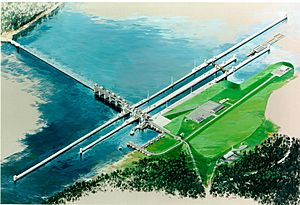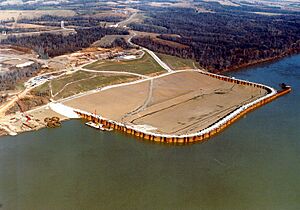Olmsted Locks and Dam facts for kids
Quick facts for kids Olmsted Locks and Dam (Locks and Dams 52 and 53 Replacement Project) |
|
|---|---|

Rendering of Olmsted Locks and Dam
|
|
| Location | |
| Coordinates | 37°11′01″N 89°03′50″W / 37.18361°N 89.06389°W |
| Construction began | December 1995 |
| Opening date | August 2018 |
| Construction cost | Estimated $3 billion+ (as of February 2018) |
| Operator(s) | United States Army Corps of Engineers Louisville District |
| Dam and spillways | |
| Impounds | Ohio River |
| Height | 62 feet (19 m) |
| Length | 2,596 feet (791 m) |
The Olmsted Locks and Dam is a huge construction project on the Ohio River. It includes special water elevators called locks and a concrete dam. This important project is located at river mile 964.4.
Its main goal is to make river travel much faster for boats and barges. It replaces two older, often crowded, locks and dams: Number 52 and Number 53. The new locks are about 17 miles upstream from where the Ohio River meets the Mississippi River. This spot is near Olmsted, Illinois.
The Olmsted project is now working. The old Locks and Dams 52 and 53 should be removed around 2020. This project is the biggest and most expensive inland waterway project ever built in the United States.
Contents
History of the Olmsted Dam
Building the Locks and Dam
The U.S. Congress first approved money for this project in 1988. They set a budget of $775 million. The lock chambers, which are like giant water elevators for boats, were finished in 2002. They are 110 feet (34 m) wide and 1,200 feet (370 m) long.
The United States Army Corps of Engineers (USACE) manages this project. They believe the new dam and locks will let boats pass through in less than one hour. Before, boats often waited 15 to 20 hours to get through the old Locks and Dams 52 and 53. This new system saves a lot of time!
Project Costs and Delays
When the project started, it was expected to cost $775 million. However, by February 2018, the estimated cost had grown to over $3 billion.
The project was first planned to be finished in 1998. But it faced many delays. It finally started working between 2018 and 2020. The old Locks and Dams 52 and 53 were then taken out of service.
The US Army Corps of Engineers says that delays in finishing the project cost the nation a lot of money. They estimate losses of about $640 million to $800 million each year. This is because businesses using the river faced higher costs due to long waits at the old locks. The new project helps move goods more cheaply than by train or truck.
How "In-the-Wet" Construction Works
Building in the Water
The Olmsted Locks and Dam Project used a special building method called "in-the-wet" construction. Usually, when building a dam on a small river, engineers create a cofferdam. This is like a temporary wall that keeps water out. Then, they drain the water inside to build on dry land.
However, the Ohio River is very busy. About 90 million tons of goods travel through this part of the river every year. Building the whole project with cofferdams would have blocked the river. This would have caused even worse delays than the old locks.
So, engineers decided to build the dam parts "in-the-wet." This means large concrete sections of the dam were built away from the river. Then, these huge pieces were brought to the river. They were carefully placed on the river bottom, causing very little trouble to boat traffic.
Why the Project Cost So Much
Challenges and Budget Increases
This project has been one of the longest and largest building jobs for the Corps of Engineers. It took 30 years to complete. The cost jumped from over $700 million to more than $3 billion by early 2018.
Several things caused these cost increases:
- Funding Delays: There wasn't always enough money available when it was needed.
- Material Costs: The price of building materials went up over time.
- Initial Budget: Engineers first guessed the project would cost less than it actually did.
- Special Construction: The "in-the-wet" method was new and complex, adding to costs.
- Contract Types: Some contracts meant the government took on most of the financial risk.
- Unexpected Problems: Engineers faced new challenges they didn't expect.
- Budget Sharing: The USACE had other projects that also needed money. This sometimes meant less money for Olmsted.
- Inflation: The general cost of everything increased over many years.
- Design Changes: The plans for the project changed over time.
- River Conditions: The Ohio River's unpredictable nature sometimes made work harder.
| Locks and dams of the Ohio River | ||
|---|---|---|
|
||
| Upstream: Smithland Lock and Dam |
Downstream: None on the Ohio River |
|



